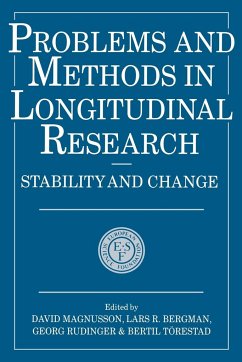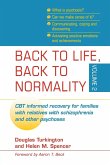Bertil TorestadStability and Change
Problems and Methods in Longitudinal Research
Stability and Change
Herausgeber: Magnusson, David; Bergman, Lars; Rudinger, Georg
Bertil TorestadStability and Change
Problems and Methods in Longitudinal Research
Stability and Change
Herausgeber: Magnusson, David; Bergman, Lars; Rudinger, Georg
- Broschiertes Buch
- Merkliste
- Auf die Merkliste
- Bewerten Bewerten
- Teilen
- Produkt teilen
- Produkterinnerung
- Produkterinnerung
An analysis of data treatment methodology for longitudinal research studies.
Andere Kunden interessierten sich auch für
![A Straight Talking Introduction to Children's Mental Health Problems A Straight Talking Introduction to Children's Mental Health Problems]() Sami TimimiA Straight Talking Introduction to Children's Mental Health Problems15,99 €
Sami TimimiA Straight Talking Introduction to Children's Mental Health Problems15,99 €![Schizophrenia Schizophrenia]() Eve C. JohnstoneSchizophrenia49,99 €
Eve C. JohnstoneSchizophrenia49,99 €![Mind, Culture, and Activity Mind, Culture, and Activity]() Michael Cole / Yrjo Engestrom / A. Vasquez (eds.)Mind, Culture, and Activity66,99 €
Michael Cole / Yrjo Engestrom / A. Vasquez (eds.)Mind, Culture, and Activity66,99 €![The Long-Term Treatment of Functional Psychoses The Long-Term Treatment of Functional Psychoses]() E. E. AnttinenThe Long-Term Treatment of Functional Psychoses41,99 €
E. E. AnttinenThe Long-Term Treatment of Functional Psychoses41,99 €![Back to Life, Back to Normality Back to Life, Back to Normality]() Back to Life, Back to Normality24,99 €
Back to Life, Back to Normality24,99 €![Stress and Adversity Over the Life Course Stress and Adversity Over the Life Course]() Ian H. Gotlib / Blair Wheaton (eds.)Stress and Adversity Over the Life Course43,99 €
Ian H. Gotlib / Blair Wheaton (eds.)Stress and Adversity Over the Life Course43,99 €![The Psychiatric Team and the Social Definition of Schizophrenia The Psychiatric Team and the Social Definition of Schizophrenia]() Rob BarrettThe Psychiatric Team and the Social Definition of Schizophrenia82,99 €
Rob BarrettThe Psychiatric Team and the Social Definition of Schizophrenia82,99 €-
-
-
Produktdetails
- Produktdetails
- Verlag: Cambridge University Press
- Seitenzahl: 368
- Erscheinungstermin: 23. Juli 2003
- Englisch
- Abmessung: 229mm x 152mm x 22mm
- Gewicht: 597g
- ISBN-13: 9780521467322
- ISBN-10: 0521467322
- Artikelnr.: 21727844
- Herstellerkennzeichnung
- Libri GmbH
- Europaallee 1
- 36244 Bad Hersfeld
- gpsr@libri.de
- Verlag: Cambridge University Press
- Seitenzahl: 368
- Erscheinungstermin: 23. Juli 2003
- Englisch
- Abmessung: 229mm x 152mm x 22mm
- Gewicht: 597g
- ISBN-13: 9780521467322
- ISBN-10: 0521467322
- Artikelnr.: 21727844
- Herstellerkennzeichnung
- Libri GmbH
- Europaallee 1
- 36244 Bad Hersfeld
- gpsr@libri.de
1. Studying individual development: problems and method; 2. Modeling
individual and average human growth data from childhood to adulthood; 3.
Intraindividual variability in older adults' depression scores: some
implications for developmental theory and longitudinal research; 4. Now you
see it, now you don't - some considerations on multiple regression; 5.
Differential development of health in a life-span perspective; 6. Assessing
of change in a cohort-longitudinal study with hierarchical data; 7.
Statistical and conceptual models of 'turning points' in developmental
processes; 8. Qualitative analysis of individual differences in
intraindividual change: examples from cognitive development; 9. Application
of correspondence analysis to a longitudinal study of cognitive
development; 10. Event history models in social mobility research; 11.
Behavioural genetic concepts in longitudinal analyses; 12. Genetic and
environmental factors in a developmental perspective; 13. Structural
equation models for studying intellectual development; 14. Longitudinal
studies for discrete data based on latent structure models; 15. Stability
and change in patterns of extrinsic adjustment problems.
individual and average human growth data from childhood to adulthood; 3.
Intraindividual variability in older adults' depression scores: some
implications for developmental theory and longitudinal research; 4. Now you
see it, now you don't - some considerations on multiple regression; 5.
Differential development of health in a life-span perspective; 6. Assessing
of change in a cohort-longitudinal study with hierarchical data; 7.
Statistical and conceptual models of 'turning points' in developmental
processes; 8. Qualitative analysis of individual differences in
intraindividual change: examples from cognitive development; 9. Application
of correspondence analysis to a longitudinal study of cognitive
development; 10. Event history models in social mobility research; 11.
Behavioural genetic concepts in longitudinal analyses; 12. Genetic and
environmental factors in a developmental perspective; 13. Structural
equation models for studying intellectual development; 14. Longitudinal
studies for discrete data based on latent structure models; 15. Stability
and change in patterns of extrinsic adjustment problems.
1. Studying individual development: problems and method; 2. Modeling
individual and average human growth data from childhood to adulthood; 3.
Intraindividual variability in older adults' depression scores: some
implications for developmental theory and longitudinal research; 4. Now you
see it, now you don't - some considerations on multiple regression; 5.
Differential development of health in a life-span perspective; 6. Assessing
of change in a cohort-longitudinal study with hierarchical data; 7.
Statistical and conceptual models of 'turning points' in developmental
processes; 8. Qualitative analysis of individual differences in
intraindividual change: examples from cognitive development; 9. Application
of correspondence analysis to a longitudinal study of cognitive
development; 10. Event history models in social mobility research; 11.
Behavioural genetic concepts in longitudinal analyses; 12. Genetic and
environmental factors in a developmental perspective; 13. Structural
equation models for studying intellectual development; 14. Longitudinal
studies for discrete data based on latent structure models; 15. Stability
and change in patterns of extrinsic adjustment problems.
individual and average human growth data from childhood to adulthood; 3.
Intraindividual variability in older adults' depression scores: some
implications for developmental theory and longitudinal research; 4. Now you
see it, now you don't - some considerations on multiple regression; 5.
Differential development of health in a life-span perspective; 6. Assessing
of change in a cohort-longitudinal study with hierarchical data; 7.
Statistical and conceptual models of 'turning points' in developmental
processes; 8. Qualitative analysis of individual differences in
intraindividual change: examples from cognitive development; 9. Application
of correspondence analysis to a longitudinal study of cognitive
development; 10. Event history models in social mobility research; 11.
Behavioural genetic concepts in longitudinal analyses; 12. Genetic and
environmental factors in a developmental perspective; 13. Structural
equation models for studying intellectual development; 14. Longitudinal
studies for discrete data based on latent structure models; 15. Stability
and change in patterns of extrinsic adjustment problems.









